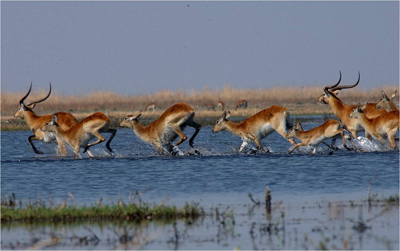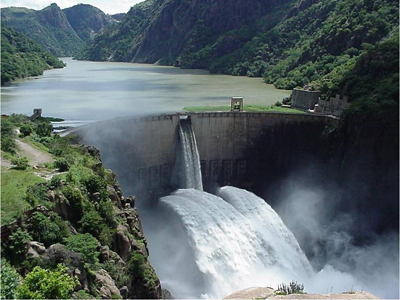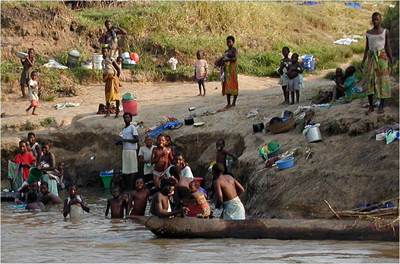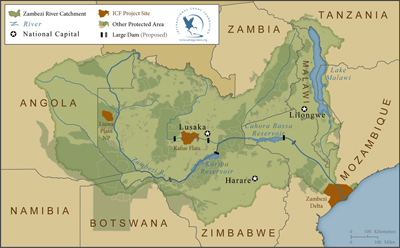ICF President Dr. Rich Beilfuss recently returned from a three-week field visit to advance ICF’s Africa Program in three important “crane countries” — Uganda, Rwanda, and Zambia. Following is part three of Rich’s field notes, highlighting river basin management in Zambia. Read Rich’s field notes from Uganda and Rwanda.
Zambia is the third leg of my travels in Africa and a perfect final destination for a crane and wetland tour. Zambia is truly a wetland paradise, with eight “Wetlands of International Importance” under the Ramsar Convention covering a surface area of nearly 40,000 square kilometers. These include some of the most important wetlands in Africa for cranes and other biodiversity. More than 90% of the global population of Wattled Cranes depends on six large floodplains, for example, and four of those are found in Zambia – Kafue Flats, Bangweulu Swamps, Liuwa Plain, and Busanga Swamps (learn more about ICF’s work in the Zambezi River basin). Another Ramsar site, the Luangwa plains, is the stronghold for Grey Crowned Cranes in Zambia. Each of these sites is formally protected but faces substantial conservation challenges—present and future.
The Zambezi River basin in southern Africa (click on the map to enlarge)
The first part of my trip to Zambia focused on the future of the Kafue Flats. The flats, a rich mosaic of grasslands, blue lagoons, and palm savannas, are home to the Kafue lechwe, a semi-aquatic antelope found nowhere else on earth, as well as Africa buffalo, zebra, wildebeest, hippo, and more than 400 bird species. Kafue Flats once supported the largest concentration of Wattled Cranes ever recorded (more than 3000 individuals), and although their numbers have declined by 60-70% over the past two decades, the flats remains the most important site for the species. The flats are well-protected on paper – two national parks and a large game management area cover much of this landscape – but are seriously degraded by upstream water regulation, illegal hunting, fires, and (most pressingly) the invasion of the thorny shrub Mimosa pigra, which now covers thousands of hectares of prime feeding grounds for Wattled Cranes and Kafue lechwe.
 Kafue lechwe
Kafue lechwe
In partnership with the WWF-Zambia Country Office and the Zambian Wildlife Authority, our plan is to aggressively attack mimosa over the next few years, until we reduce it down to a level where park scouts can keep it at bay. We will hire about 80 local community members to aid in the effort. I was eager to share an exciting break-through with my Zambia colleagues. ICF’s Southeast Asia Program Manager, Tran Triet, and his colleagues have just discovered that a concentrated salt water solution is effective at killing Mimosa pigra at Tram Chim National Park in Vietnam, where it also has invaded large areas. This would be a much lower-cost and less toxic alternative to spraying herbicide on the mimosa clones here, and we make an immediate plan to begin testing salt spray on the flats.

Water release from the Cahora Bassa Dam, Mozambique
During the final week of my stay in Zambia, we held our twice-yearly stakeholders meeting for our Joint Zambezi River Basin Environmental Flows Programme. This is an exciting, ambitious initiative of WWF, ICF, and other partners. The program is the largest scale effort in the world to implement basin-wide environmental flows (or “eflows”) that specify the quantity, timing, and quality of water flows required to sustain freshwater and estuarine ecosystems and the human livelihoods and well-being that depend on these ecosystems. We are joined at this meeting by representatives from all the major dams in the Zambezi River basin, as well as those responsible for water allocation, management, and flood forecasting. We have long focused on water releases from large dams in Zambia, Zimbabwe, and Mozambique, which affect the Kafue Flats, Zambezi Delta, and other vital wetlands for people and wildlife, and with this meeting we also expand our focus to include the vital Zambezi headwaters regions of Angola, Zambia, and Malawi.

Local human populations, as well as wildlife, depend on the wise management of rivers in the Zambezi River basin.
Dr. Jackie King, one of the founders of the science of environmental flows, and I gave a half-day presentation on global progress with eflows and the history of and prospects for sustainable water management in the Zambezi basin. This included considerable focus on the efforts ICF has led to release waters from Cahora Bassa Dam for the Lower Zambezi River and Delta in Mozambique. Later in the workshop, our attention focused on two key actions – setting a plan and timetable for a series of stakeholder workshops over the next two years that will be used to specifically define the water needs and management alternatives for the Zambezi basin, and launching a basin-wide monitoring and adaptive management plan. I was responsible for the latter – preparing and presenting the monitoring and adaptive management plan to stakeholders- and I spent much of my time sharing a vision for basin monitoring that will clearly demonstrate the ecological and socio-economic benefits of environmental flows for decision-makers and all who use or care about Zambezi waters. We reached broad agreement on the plan as a three-way partnership between the water authorities and dam operators (monitoring hydrology), government agencies (monitoring social and economic indicators), and conservation NGOs such as ICF and WWF (monitoring key ecological variables and species of concern). Wattled Cranes, a key flagship species for Zambezi eflows, figure prominently in our monitoring system.
Next year I will lead a trip back to Zambia to visit some of the extraordinary places we are working to save, including the Kafue Flats, Busanga Plains, and South Luangwa National Park. I hope you will join me on this next adventure to the wetland capital of Africa (learn more about this exciting opportunity!).

